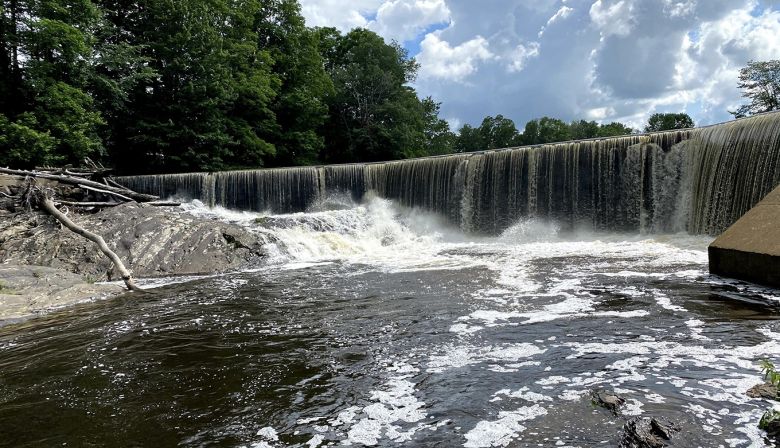
Subscribe & stay up-to-date with ASF


There have been many changes to our environment over the years due to human development. One of these changes is to the flow of waterways. Dams have been used for many generations for various reasons, control of floods, production of electricity, and in earlier times to power mills via water wheels. In 1781 a dam was built for a sawmill in Farmington Falls. While it was productive for its time, today we realize that the changes to Wilson Stream have had a profound effect upon the native wild life. Salmon in particular were not able to reach their spawning grounds above the dam.
Atlantic Salmon are now an endangered species.
They became extinct in the 1800’s in Long Island Sound and along most of the coast of central New England. Atlantic salmon once occupied 34 rivers and streams in Maine (Beland 1984, Rounsefell and Bond 1949). Today, wild Atlantic salmon populations in the United States are found only in Maine, from the lower Kennebec River in the southwest to the Canadian border. “Fewer than 3,000 adults returned per year in the 1960s and 1970s (Large stocking efforts in the Penobscot River led to a brief period of annual returns numbering 3,000–5,000 fish, but returns to the Penobscot and the other rivers have declined precipitously since the early 1990s” according to the National Research Council’s book, Salmon in Maine. There are several reasons for this decline: climate change, changes to waterway flows, increased predation upon the young salmon and lack of good habitat for the young fish.
Atlantic salmon begin their lives in freshwater where the young grow to several inches in length, then migrate to the sea, where they grow more rapidly and become sexually mature after one, two, or three years (Baum 1997) When the young emerge they carry the egg sack with them and are called fry. This usually occurs in May. They grow during the summer into Parr, which are young salmon with 8–11 vertical dark bands on their sides. This striping helps the fish hide from predators. It usually takes two years for the parr to grow big enough for the next stage. Winter mortality is associated with the parr’s habitat, which may be marginal in providing refuge during their last winter in freshwater. The pre-migrant parr are relatively large for their habitat and they often live beneath winter ice (Cunjak et al. 1998). The mortality of pre-migrant parr may be quite high for some populations. Warming climates are a large cause of the instability of the ice cover but also lack of fallen trees left in the streams causes fewer spots for the parr to hide.
Salmon are ectothermic which means that their body temperature fluctuates with their environment. The temperatures in streams and in the ocean will affect how fast they develop. Growth and size determine the timing of the parr-smolt transformation. Smolts are silvery, without parr marks and with a more streamlined body. The parr smolt transformation is of key importance because the smolt faces the challenge of both a seaward migration and changes to parts of their bodies, like the gills, that allow the fish to remove excess salt and utilize the oxygen in the salt water. It is believed that water temperature and the length of daylight determine when the smolts will start off toward the ocean. The warmer the water the shorter the window for smolts to set off to the sea. Dams and other obstructions as well as the general warming of the climate all affect the water temperature and this warming has a negative impact on smolt migration to the ocean. In the case of our salmon population the route the smolts take is to enter the Sandy River from Temple Stream. The Sandy River enters into the Kennebec River. The Kennebec then goes through Merry Meeting Bay before flowing into the ocean near Casco Bay.
When the smolts enter the sea water they are called post-smolts until the beginning of the next year when they officially become salmon. During the oceanic phase, juveniles from most river systems migrate to subpolar seas to feed for two or more years before returning to their native streams. For Maine smolts this is off the coast of Nova Scotia. The migration usually takes 45 to 60 days. Some smolts go up as far as Labrador. Maine’s salmon are usually larger in size as they take 2 years to mature in the ocean. Each female can lay around 7,000 eggs. Warmer water temperatures also cause the salmon to mature faster but this means they are smaller and will lay less eggs. It has been estimated that in order to keep the salmon population from decreasing two percent of the smolts that leave the streams for the ocean would have to return to spawn. Predation by birds, seals and other fish play havoc on the migrating salmon.
While the larger problem of climate change will be much harder for us to have a big impact on, we can do our part to save the Atlantic Salmon population from going extinct by removing obstacles to fish migration and providing environments that allow the Parr to survive better. The Farmington Conservation Commission is working with the Atlantic Salmon Federation to remove the dam on Wilson stream as well as building areas upstream that the Parr can use for cover as they grow. Hopefully we can keep these amazing creatures as part of our community for generations to come.